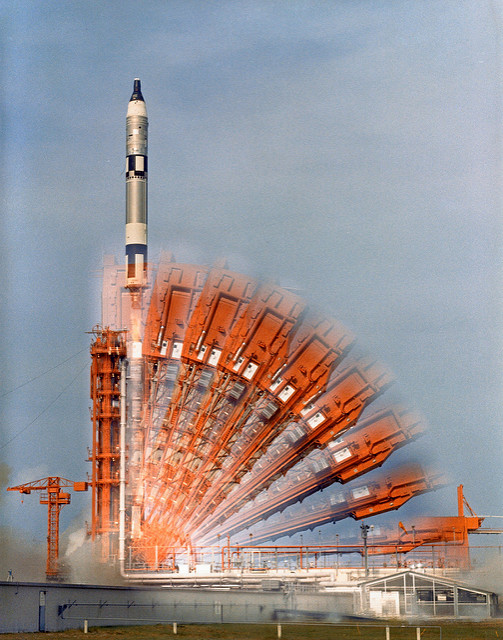News
ICBM rocket shopping: Elon Musk did it in Russia, so why not do it in the United States?
The ultimate goal of launching rockets is to get us exploring and building in space, not picking winners and losers. Simply put, if you can’t compete with the mousetraps on the market, you haven’t actually built a better mousetrap. Repurposed ICBM motors for rocket engines are not the problem.


Gemini 10 launches on a modified Titan ICBM motor. Credit: NASA on The Commons.
A Disagreement Among Star Travelers
There’s a debate going on among the government “powers that be” and commercial space companies over the use of excess intercontinental ballistic missile (ICBM) motors to launch rockets. Currently, these motors are banned from being used for commercial purposes, although military and civil launches are okay.
One side argues that the ban should be lifted because
- the missile parts provide a reliable, cost-effective means for space access; and
- it benefits taxpayers through recouped monies from private sales.
The other side wants the ban maintained because
- flooding the market with cheaper, “off-the-shelf” rocket parts could hinder the innovation and development of new rocket technologies by lowering demand for them; and
- larger companies will take away their market share through easy access to cheaper motors.
This same debate created the ban in the 1990s, and it should be mentioned that the main proponent of lifting the ban was a big part of passing it in the first place. It is also only fair to mention that this main proponent is a very large, established rocket company while the opponents are mostly smaller competitors.
Putting It All Into Perspective
First, it’s important to consider a reality-based context before taking a position on this. Absent another world war, globalization is here to stay, meaning that if a company in the United States cannot offer launch services at a  competitive price point, their potential customers will go elsewhere. Since these customers are not exclusively American companies, U.S. lawmakers cannot simply make the problem go away through legislation by restricting the nationality of launch providers.
competitive price point, their potential customers will go elsewhere. Since these customers are not exclusively American companies, U.S. lawmakers cannot simply make the problem go away through legislation by restricting the nationality of launch providers.
Second, it’s important to frame this issue using marketplace case studies relevant to the situation found here. Old technology is constantly giving way to updated and new technology, demonstrating that innovation is driven by a variety of factors, not just the pure need for a technology to exist.
Finally, it’s important to fully understand the motives of all parties involved. The commercial space industry is, by definition, business-oriented. At a fundamental level, all parties involved are concerned primarily with their own best interest, i.e., their ability to make a profit.
Space Access Should Be More Affordable
In my opinion, the ban should be lifted, as my position on issues like this will always tend towards expanding access rather than restricting it. Achieving democratized space travel will require affordable accessibility to space, and one of the best ways to drive costs down is to not spend valuable resources “reinventing the wheel” if existing resources work well for current needs. This isn’t to say that innovation isn’t necessary, but rather that different  missions have different needs, and the existence of one option doesn’t preclude the need for other options.
missions have different needs, and the existence of one option doesn’t preclude the need for other options.
The car industry is a good case study to compare to. The fact that older cars
exist does not prevent newer, generally improved cars from being developed and sold each year. Gasoline is a proven standard to fuel vehicles, but the demand for electric vehicles is getting louder. It’s the demand for better technology that moves this process of innovation forward.
The companies involved in this debate are profit-driven. What would motivate a company to keep inexpensive, proven technology out of a market they were competing in? In my opinion, the question itself contains the answer. Competition is a proven way to drive development, and the argument that a market flooded with competition would hurt competition has somewhat circular logic.
I do think it is fair to be concerned that the nature of competing against government for a product undermines the concept of a fair market; however, the global nature of launch services and the expanding need for more innovative solutions, i.e., more powerful rocket engines for the upcoming long-distance space missions, mitigate this concern.
 In the current environment, American launch providers are losing business to non-American launch providers, most of which are either heavily subsidized by their governments or are the governments themselves. In order for American launch providers to afford the costs of innovation and development, they need to be able to fairly compete in the global market for a customer base. It is also important to note that the rocket motor is only one part of the process of providing launch services. In that light, opening the ICBM market to American launch providers doesn’t make the American government the competitor as much as it is a retailer selling certain parts which make up a whole rocket product.
In the current environment, American launch providers are losing business to non-American launch providers, most of which are either heavily subsidized by their governments or are the governments themselves. In order for American launch providers to afford the costs of innovation and development, they need to be able to fairly compete in the global market for a customer base. It is also important to note that the rocket motor is only one part of the process of providing launch services. In that light, opening the ICBM market to American launch providers doesn’t make the American government the competitor as much as it is a retailer selling certain parts which make up a whole rocket product.
Elon Musk, Russians, and ICBM Engines (Oh, my!)
To frame this debate in another light, recall that Elon Musk’s initial space dreams involved purchasing ICBM motors from Russia to send dehydrated plant seeds to Mars. He wanted to accomplish something inspirational without diving head first into the business of building rockets. Fortunately for us, SpaceX was born through that process; however,  imagine a future, space-inspired millionaire looking to make a similar contribution except the purpose would ultimately be commercial. Why deny the option of a rocket built with “off-the-shelf” parts? There aren’t many Elon Musk types out there willing to invest most of their own personal fortune for a ten percent chance of success at building a rocket engine from scratch, but every time technology is sent into space, it moves us forward.
imagine a future, space-inspired millionaire looking to make a similar contribution except the purpose would ultimately be commercial. Why deny the option of a rocket built with “off-the-shelf” parts? There aren’t many Elon Musk types out there willing to invest most of their own personal fortune for a ten percent chance of success at building a rocket engine from scratch, but every time technology is sent into space, it moves us forward.
Elon Musk’s ICBM story isn’t the only thing worth noting in this debate. Unfortunately for supporters of the ban, SpaceX essentially renders their argument moot because SpaceX’s innovation and resulting lower launch price tag are what’s making Russian space authorities somewhat cranky about the business they’re usurping from them. Clearly, innovation is still possible even with other ICBM-based rockets on the market.
In Summary
The ultimate goal of launching rockets is to get us exploring and building in space, and this is hindered when the regulatory environment has the effect of hand picking winners and losers. Restricting ICBM motors from being on the commercial market does exactly that. This doesn’t advance the long term goals of space exploration. It only interferes with getting technology into orbit and beyond by restricting the capital available to develop better technology.
 The argument that innovation is hurt by a market full of ICBM motors is one based on a desire to control market forces in an unfair way. Simply put, if you can’t compete with the mousetraps on the market, you haven’t actually built a better mousetrap, and there’s nothing to prevent you from selling existing mousetraps in service packages while you develop better ones.
The argument that innovation is hurt by a market full of ICBM motors is one based on a desire to control market forces in an unfair way. Simply put, if you can’t compete with the mousetraps on the market, you haven’t actually built a better mousetrap, and there’s nothing to prevent you from selling existing mousetraps in service packages while you develop better ones.
Granted, as Elon Musk has reminded us in several interviews, rockets are hard, making the business of rockets even harder. Imagine, however, if the government banned access to all major highways, an existing tax-funded resource, because there was a need for a surface material that was resistant to pot holes and existing asphalt mixes hindered its development. It doesn’t take a rocket scientist to see what a bad idea that would be and what type of impact it would have on those needing the highways to conduct their business, especially while other countries still had their road systems up and running.
Autobahn, anyone?

News
Tesla dominates in the UK with Model Y and Model 3 leading the way

Tesla is dominating in the United Kingdom so far through 2025, and with about two weeks left in the year, the Model Y and Model 3 are leading the way.
The Model Y and Model 3 are the two best-selling electric vehicles in the United Kingdom, which is comprised of England, Scotland, Wales, and Northern Ireland, and it’s not particularly close.
According to data gathered by EU-EVs, the Model Y is sitting at 18,890 units for the year, while the Model 3 is slightly behind with 16,361 sales for the year so far.
The next best-selling EV is the Audi Q4 e-tron at 10,287 units, lagging significantly behind but ahead of other models like the BMW i4 and the Audi Q6 e-tron.
GOOD NEWS 🇬🇧 Tesla is absolutely crushing the UK electric vehicle market in 2025 💥
The numbers are in, and the dominance is clear. With an impressive amount of 42,270 vehicles delivered year-to-date, the brand now commands a solid 9.6% market share of the total auto market 🆒… pic.twitter.com/dkiGX9kzd0
— Ming (@tslaming) December 18, 2025
The Model Y has tasted significant success in the global market, but it has dominated in large markets like Europe and the United States.
For years, it’s been a car that has fit the bill of exactly what consumers need: a perfect combination of luxury, space, and sustainability.
Both vehicles are going to see decreases in sales compared to 2024; the Model Y was the best-selling car last year, but it sold 32,610 units in the UK. Meanwhile, the Model 3 had reached 17,272 units, which will keep it right on par with last year.
Tesla sold 50,090 units in the market last year, and it’s about 8,000 units shy of last year’s pace. It also had a stronger market share last year with 13.2 percent of the sales in the market. With two weeks left in 2025, Tesla has a 9.6 percent market share, leading Volkswagen with 8 percent.
The company likely felt some impact from CEO Elon Musk’s involvement with the Trump administration and, more specifically, his role with DOGE. However, it is worth mentioning that some months saw stronger consumer demand than others. For example, sales were up over 20 percent in February. A 14 percent increase followed this in June.
News
Tesla Insurance officially expands to new U.S. state
Tesla’s in-house Insurance program first launched back in late 2019, offering a new way to insure the vehicles that was potentially less expensive and could alleviate a lot of the issues people had with claims, as the company could assess and repair the damage itself.

Tesla Insurance has officially expanded to a new U.S. state, its thirteenth since its launch in 2019.
Tesla has confirmed that its in-house Insurance program has officially made its way to Florida, just two months after the company filed to update its Private Passenger Auto program in the state. It had tried to offer its insurance program to drivers in the state back in 2022, but its launch did not happen.
Instead, Tesla refiled the paperwork back in mid-October, which essentially was the move toward initiating the offering this month.
BREAKING: Tesla Insurance has just officially launched in Florida.
This is the first new state to receive @Tesla Insurance in more than 3 years. In total, Tesla insurance is now available in 13 U.S. states (map in thread below of all the states).
Tesla Insurance in Florida uses… pic.twitter.com/bDwh1IV6gD
— Sawyer Merritt (@SawyerMerritt) December 17, 2025
Tesla’s in-house Insurance program first launched back in late 2019, offering a new way to insure the vehicles that was potentially less expensive and could alleviate a lot of the issues people had with claims, as the company could assess and repair the damage itself.
It has expanded to new states since 2019, but Florida presents a particularly interesting challenge for Tesla, as the company’s entry into the state is particularly noteworthy given its unique insurance landscape, characterized by high premiums due to frequent natural disasters, dense traffic, and a no-fault system.
Annual average premiums for Florida drivers hover around $4,000 per year, well above the national average. Tesla’s insurance program could disrupt this, especially for EV enthusiasts. The state’s growing EV adoption, fueled by incentives and infrastructure development, aligns perfectly with Tesla’s ecosystem.
Moreover, there are more ways to have cars repaired, and features like comprehensive coverage for battery damage and roadside assistance tailored to EVs address those common painpoints that owners have.
However, there are some challenges that still remain. Florida’s susceptibility to hurricanes raises questions about how Tesla will handle claims during disasters.
Looking ahead, Tesla’s expansion of its insurance program signals the company’s ambition to continue vertically integrating its services, including coverage of its vehicles. Reducing dependency on third-party insurers only makes things simpler for the company’s automotive division, as well as for its customers.
News
Tesla Full Self-Driving gets sparkling review from South Korean politician
“Having already ridden in an unmanned robotaxi, the novelty wasn’t as strong for me, but it drives just as well as most people do. It already feels like a completed technology, which gives me a lot to think about.”

Tesla Full Self-Driving got its first sparkling review from South Korean politician Lee So-young, a member of the country’s National Assembly, earlier this week.
Lee is a member of the Strategy and Finance Committee in South Korea and is a proponent of sustainable technologies and their applications in both residential and commercial settings. For the first time, Lee was able to utilize Tesla’s Full Self-Driving technology as it launched in the country in late November.
Her thoughts on the suite were complimentary to the suite, stating that “it drives just as well as most people do,” and that “it already feels like a completed technology.”
드디어 오늘, 서울에서 테슬라 FSD 체험 했습니다.
JiDal Papa님의 모델S 협찬에 힘입어^^ 파파님 정말 감사합니다.
국회 -> 망원시장 -> 홍익대 -> 국회 복귀 코스였고요.
이미 무인 로보택시를 타봐서 그런지 신기함은
덜했지만, 웬만한 사람만큼 운전을 잘하네요.이미 완성된 기술이라고… pic.twitter.com/8pAidHBpRG
— 이소영 국회의원 (Soyoung Lee) (@im_soyounglee) December 17, 2025
Her translated post says:
“Finally, today I got to experience Tesla FSD in Seoul. Thanks to the Model S sponsored by JiDal Papa^^, I’m truly grateful to Papa. The route was from the National Assembly -> Mangwon Market -> Hongik University -> back to the National Assembly. Having already ridden in an unmanned robotaxi, the novelty wasn’t as strong for me, but it drives just as well as most people do. It already feels like a completed technology, which gives me a lot to think about. Once it actually spreads into widespread use, I feel like our daily lives are going to change a lot. Even I, with my license gathering dust in a drawer, don’t see much reason to learn to drive a manual anymore.”
Tesla Full Self-Driving officially landed in South Korea in late November, with the initial launch being one of Tesla’s most recent, v14.1.4.
It marked the seventh country in which Tesla was able to enable the driver assistance suite, following the United States, Puerto Rico, Canada, China, Mexico, Australia, and New Zealand.
It is important to see politicians and figures in power try new technologies, especially ones that are widely popular in other regions of the world and could potentially revolutionize how people travel globally.








